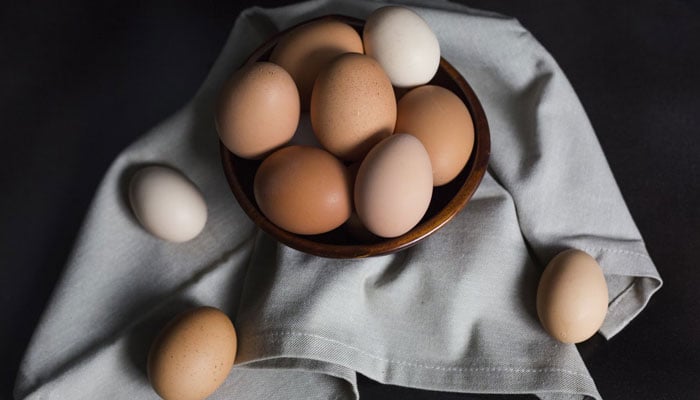Pakistan’s egg market scrambles amid feed shortages and inflation
LAHORE: Consumers are feeling the pinch of soaring egg prices as the winter season boosts demand for the breakfast staple, while poultry farmers struggle to cope with rising production costs and feed shortages, industry officials said on Wednesday.
When eggs are in most demand, they become the dearest after gradually start vanishing from the market, rues consumers. They complained that price of eggs is not only on the rise but it is not being supplied in the market as per demand.
“Shopkeeper in my market told us that he has not been supplied eggs for last three days,” said a consumer in provincial capital Lahore. For the last couple of weeks, average wholesale price of egg in the Punjab province witnessed a jump of Rs30 per dozen. From December 02, 2023 till date, according to official price monitoring by the provincial government, eggs become costlier by Rs02 per dozen on daily basis, skyrocketing its rate to Rs363 per dozen.
If present ascending trend in egg prices continues, it may cross over Rs400 per dozen mark, costing lofty price of an egg to Rs50 for consumer. They already complained that shopkeepers are selling five eggs at Rs200 rate and its per dozen price at many places spiked to Rs390 to Rs400 per dozens. As per official report, eggs in Multan are being sold at highest wholesale price of Rs382 per dozens followed by Rs370 each in Bahwalpur and Rahim Yar Khan. In Lahore and most of other cities, prices are relatively lower, hovering around Rs 360 per dozens with exception of Rawalpindi and Dera Ghazi Khan where prices are Rs355 and Rs345 respectively.
Dairy & Cattle Farmers Association (DCFA) blamed egg price escalation by traders and shopkeepers. The eggs are being sold in the market more than the official rate. The shopkeepers claimed that the eggs are being sold to them at Rs375 per dozen against the official rate of Rs360. The huge jump in cost of production is also one of the reasons ballooning rate of this essential commodity.
Nevertheless, eggs are simply 'noneggistent' in various markets mainly due to low production on the back of steep rise in cost of production. Blaming multiple factors, stakeholders warn that price escalation would be worse in coming days as it may continue by end of February 2024. Eggs are in short production and supplies have severely been curtailed. The current egg market is experiencing significant disruptions due to a complex interplay of supply and demand factors. Seasonal demand has surged, yet egg availability is constrained as poultry farmers report a substantial 40 percent reduction in new flock placements compared to previous seasons.
This shortfall in production primarily stems from inflationary pressures affecting various sectors, including poultry farming. Apart from massive jump in energy, transportation and ther costs, a critical issue is the soaring cost of raw material, especially soybean meal, which a key component in poultry feed. The price for rearing new flocks has escalated by 50 percent, largely due to this feed ingredient's scarcity and high costs, said Khaleeq Arshad, a leading player in the poultry industry.
Feed mills have struggled to procure sufficient soybean meal, leading to feed shortages and exorbitant prices. Consequently, farmers have been unable to acquire the necessary feed, resulting in a 40 percent decrease in new flock placements. These factors collectively contribute to the rising egg prices and limited supply in the market. Even farmers who have managed to raise new flocks amid these challenges, incurring 50 percent higher rearing costs, find themselves unable to reduce their selling prices, further exacerbating the situation, he observed.
Prof. Talat Pasha, a leading academician and an acclaimed poultry expert was of the view that layer cycle is of two-years duration. Various issues regarding feed ingredients and premixes including soyabean shortage last year sent cost of production through the roof. The losses of farmers in the last cycle and high input cost in current layer cycle affected production on large scale.
Pasha, who was also former Vice Chancellor of University of Veterinary & Animal Sciences (UVAS) warned that disruption in production since last year have resulted in price rise and gaps in supply line. On urgently basis, we can’t do anything, he added. Currently we have 60 percent layer in production, which is leading to short supply in the market. This year, there is good placement expected and hopefully next year prices will be in favour of consumer, he hoped.
-
 Prince Harry's Lawyer Tells Court Daily Mail Complicit In Unlawful Acts
Prince Harry's Lawyer Tells Court Daily Mail Complicit In Unlawful Acts -
 Meghan Markle Named In Epstein Files With Ghislaine Maxwell?
Meghan Markle Named In Epstein Files With Ghislaine Maxwell? -
 Drunk Driver Tries To Snatch San Diego Deputy’s Gun During Chase
Drunk Driver Tries To Snatch San Diego Deputy’s Gun During Chase -
 After Surgery, Piers Morgan Reminded Of His Remarks About Meghan's Father's Hospitalization
After Surgery, Piers Morgan Reminded Of His Remarks About Meghan's Father's Hospitalization -
 Idris Elba Gets Honest About Managing Real-life Hijack Situation
Idris Elba Gets Honest About Managing Real-life Hijack Situation -
 Royal Family Buries King Charles' Cousin
Royal Family Buries King Charles' Cousin -
 Elizabeth Hurley Faces An Impossible Choice As Son Damian, Beau Billy Ray Cyrus Clash
Elizabeth Hurley Faces An Impossible Choice As Son Damian, Beau Billy Ray Cyrus Clash -
 Rare Pokémon Cards Worth $100k Stolen In New York Shop Robbery
Rare Pokémon Cards Worth $100k Stolen In New York Shop Robbery -
 Chevy Chase Shares Disappointment After 'SNL50: The Anniversary Special' Snub
Chevy Chase Shares Disappointment After 'SNL50: The Anniversary Special' Snub -
 Samuel L. Jackson's Old Movie Found New Life: Here's How
Samuel L. Jackson's Old Movie Found New Life: Here's How -
 Nobel Prize Snub Hardens Donald Trump's Tone On ‘peace’
Nobel Prize Snub Hardens Donald Trump's Tone On ‘peace’ -
 What's Prince Harry's Case Against The Daily Mail's Publisher?
What's Prince Harry's Case Against The Daily Mail's Publisher? -
 'Matilda' Star Mara Wilson Breaks Silence On AI's 'deepfake Apocalypse' After Being Abused
'Matilda' Star Mara Wilson Breaks Silence On AI's 'deepfake Apocalypse' After Being Abused -
 Meghan Markle 'ruined' Prince Harry's Life?
Meghan Markle 'ruined' Prince Harry's Life? -
 Super Bowl Halftime Show Gets Another Attraction Besides Bad Bunny
Super Bowl Halftime Show Gets Another Attraction Besides Bad Bunny -
 Princess Irene's Coffin Arrives For Funeral Rites
Princess Irene's Coffin Arrives For Funeral Rites




